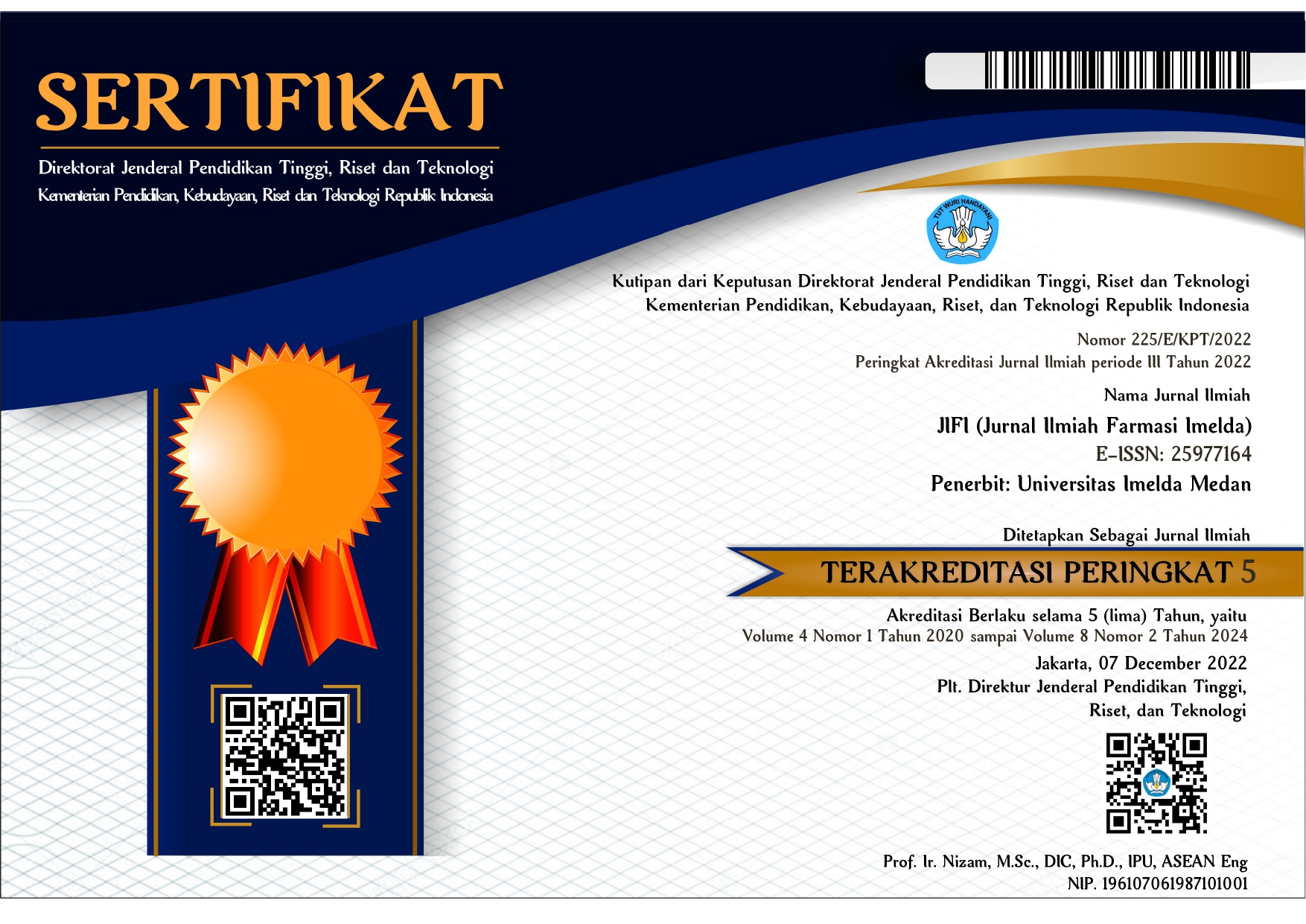ISOLASI DAN ELUSIDASI STRUKTUR SENYAWA DARI EKSTRAK BAWANG DAYAK SERTA UJI AKTIVITAS ANTIBAKTERINYA
DOI:
https://doi.org/10.52943/jifarmasi.v4i2.501Keywords:
bawang dayak, antibakteri, isolasi, HongconinAbstract
Skrining aktivitas antibakteri dilakukan terhadap 10 spesies tanaman obat yang secara empiris telah digunakan dalam pengobatan tradisional di Indonesia, di antaranya umbi bawang dayak (Eleutherine bulbosa), herba ki tolod (Isotoma longiflora), buah ketepeng cina (Cassia alata), dan daun bluntas (Pluchea indica). Berdasarkan hasil skrining aktivitas antibakteri, ekstrak umbi bawang dayak (Eleutherine bulbosa) menunjukkan aktivitas antibakteri paling dominan terhadap Bacillus subtilis dan Staphylococcus aureus pada konsentrasi ekstrak 200 dan 100 ?g/ml, serta terhadap Klebsiella pneumoniae pada konsentrasi ekstrak 200 ?g/ml. Purifikasi dan isolasi senyawa serta uji aktivitas antibakteri dilakukan untuk mengetahui senyawa yang bertanggung jawab atas aktivitas antibakteri dari ekstrak bawang dayak. Dari hasil purifikasi dan isolasi senyawa menggunakan MPLC, kolom kromatografi, serta KLT preparatif, dihasilkan suatu senyawa isolat (4 mg). Senyawa tersebut dianalisis menggunakan LR-EIMS serta 1D-2D NMR, dan selanjutnya diidentifikasi sebagai Hongconin. Uji aktivitas antibakteri ekstrak bawang dayak dan senyawa isolat menunjukkan hasil ekstrak bawang dayak mempunyai aktivitas antibakteri yang tergolong moderat/sedang terhadap B. subtilis, S. aureus, dan K. pneumoniae, ditunjukkan dengan nilai KHM antara 100-200 ?g/ml. Sementara itu, senyawa isolat (Hongconin) mempunyai aktivitas antibakteri yang tergolong lemah terhadap semua jenis bakteri patogen yang diujikan, ditunjukkan dengan nilai KHM >200 ?M.
Kata kunci: bawang dayak, antibakteri, isolasi, Hongconin
References
Okeke, I.N., Laxminarayan, R., Bhutta, Z.A., Duse, A.G., Jenkins, P., O’Brien, T.F., Pablos-Mendez, A., Klugman, K.P., 2005, Antimicrobial resistance in developing countries. Part I: Recent trends and current status, The Lancet Infectous Disease, 5, 481–493.
Kemenkes RI, 2020, Profil Kesehatan Indonesia Tahun 2019, https://www.kemkes.go.id/folder/view/01/structure-publikasi-pusdatin-profil-kesehatan.html, diakses tanggal 24 Januari 2021.
Uche-Okereafor, Nkemdinma, Sebola, M., Tapfuma, K., Mekuto, L., Green, E., Mavungmengwana, V., 2019, Antibacterial Activities of Crude Secondary Metabolite Extracts from Pantoea Species Obtained from the Stem of Solanum mauritianum and Their Effects on Two Cancer Cell Lines, International Jurnal of Environmental Research and Public Health, 16, 602.
Reichling, J., 2010, Plant-microbe interactions and secondary metabolites with antibacterial, antifungal, and antiviral properties, in Annual Plant Reviews volume 39: functions and biotechnology of plant secondary metabolites: Wiley-Blackwell Publishing, Iowa, USA, 2nd edition, pp 214−317.
Hussain H, Al-Harrasi A, Abbas G, Rehman NU, Mabood F, Ahmed I, Saleem M, Van Ree T, Green IR, Anwar S, Badshah A, Shah A, Ali I., 2013, The Genus Pluchea :Phytochemistry,Traditional Uses, and Biological Activities. Chemistry and Biodiversity, 10, 1944-1971.
Dalimartha S., 2000, Atlas Tumbuhan Obat Indonesia. Trubus Agriwidya, Jakarta.
Siregar R.M., 2015, Antibacterial Activity of Kitolod (Laurentia longiflora (L). Peterm) Leaf and Flower Extact Against Several Conjunctivity Causing Bacteria, Institut Pertanian Bogor, 1 (L), 8.
Banso A., 2009, Phytochemical and antibacterial investigation of bark extracts of Acacia nilotica, Journal of Medicinal Plants Research, 3, 82-85.
Naumann H.D., Tedeschi L.O., Zeller W.E., Huntley N.F., 2017, The role of condensed tannins in ruminant animal production: advances, limitations and future directions, Brazilian Journal of Animal Science 46(12): 929-949.
Kumar, S., and Pandey A.K., 2013, Chemistry and Biological Activities of Flavonoids: An Overview, The Scientific World Journal, 1, 1-16.
Nitiema, L.W., Savadogo, A., Simpore, J., Dianou, D., Traore, A.S., 2012, In vitro Antimicrobial Activity of Some Phenolic Compounds (Coumarin and Quercetin) Against Gastroenteritis Bacterial Strains, International Journal of Microbiological Research 3(3): 183-187.
Malekinejad, H.; Gilani, B. B.; Tukmechi, A.; Ebrahimi, H. A cytotoxicity and comparative antibacterial study on the effect of Zataria multiflora Boiss, Trachyspermum copticum essential oils, and Enrofloxacin on Aeromonas hydrophila. Avicenna J. Phytomed. 2012, 2, 188−195.
Salton, M.R.J.; Kim, K.S. Structure. In Medical Microbiology, 4th ed.; Baron, S., Ed.; University of Texas Medical Branch at Galveston: Galveston TX, USA, 1996; Chapter 2; https://www.ncbi.nlm.nih.gov/ books/NBK8477/, diakses tanggal 22 Januari 2021.
Insanu, M., Kusmardiyani, S., Hartati, R., 2014, Recent Studies on Phytochemicals and Pharmacological Effects of Eleutherine americana Merr., Procedia Chemistry 13, 221-228.
Fernandes, R.A., Chavan, V.P., 2010, A Concise Asymmetric Synthesis of (–)‐Hongconin and (–)‐1‐epi‐Hongconin, European Journal of Organic Chemistry, 22, 4306-4311.
Zhengxiong, C., Huizhu, H., Chengrui, W., Yuhui, L., Jianmi,D., Sankawa U., Noguchi H. and Itaka Y., 1986, Hongconin, a New Naphthalene Derivative from Hong-Cong, the Rhizome of Eleutherine ameicana MERR. et HEYNE(Iridaceae), Chem. Pharm. Bull., 34(7): 2743–2746.
Ifesan, B.O., Hamtasin, C., Mahabusarakam, W., Voravuthikunchai S.P., 2009, Assessment of antistaphylococcal activity of partially purified fractions and pure compounds from Eleutherine Americana, Journal of Food Protection, 72(2): 354-359.
Balouiri, M.; Sadiki, M.; Ibnsouda, S, K., 2016, Methods for in vitro evaluating antimicrobial activity: a review, Journal of Pharmaceutical Analysis, 6, 71−79.
Grela, E., Kozłowska, J., Grabowlecka, A., 2018, Current methodology of MTT assay in bacteria - A review, Acta Histochemica, 120(4):303-311.
Kuete, V., 2010, Potential of Cameroonian plants and derived products against microbial infections: a review, Planta Medica, 76(14): 1479-1491.
Ieyama T, Gunawan-Puteri MDPT, Kawabata J, 2011, a-Glucosidase inhibitors from the bulb of Eleutherine Americana, Food Chemistry, 128, 308-311.
Sirirak T, SP. Voravuthikunchai, 2011, Eleutherine americana: A candidate for the control of Campylobacter species. Poultry Science, 90, 791-796.
Ifesan B.O., Joycharat N., Voravuthikunchai, S.P., 2009, The mode of antistaphylococcal action of Eleutherine americana. FEMS Immunology and Medical Microbiology, 57, 193-201.
Caamal-Fuentes, E.E., Peraza-Sanchez, S.R., Torres-Tapia, L.W., Moo-Puc, R.E., 2015, Isolation and Identification of Cytotoxic Compounds from Aeschynomene fascicularis, a Mayan Medicinal Plant, Molecules, 20(8), 13563-13574.
Meletiadis, J., Meis, J.F.G.M., Mouton, J.W., 2001, Analysis of growth characteristics of filamentous fungi in different nutrient media, Journal of Clinical Microbiology, vol 39, pp. 478-484.









